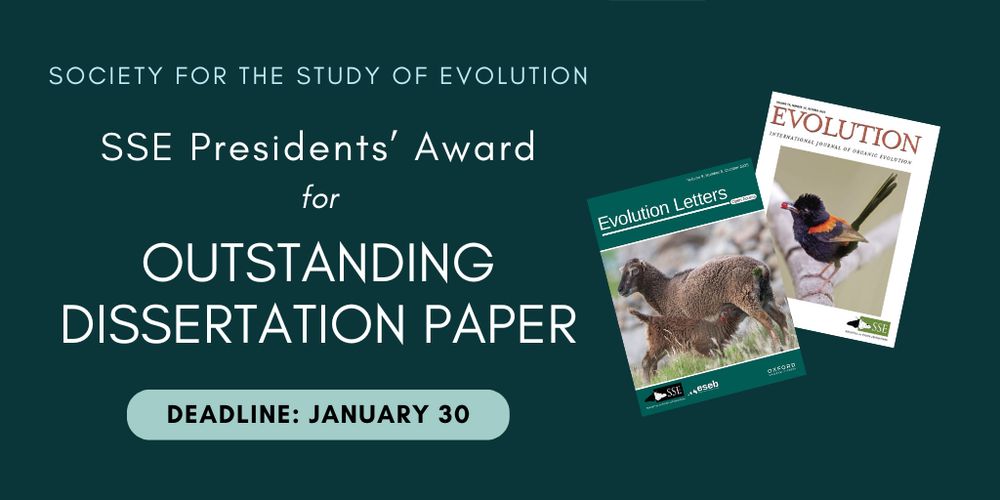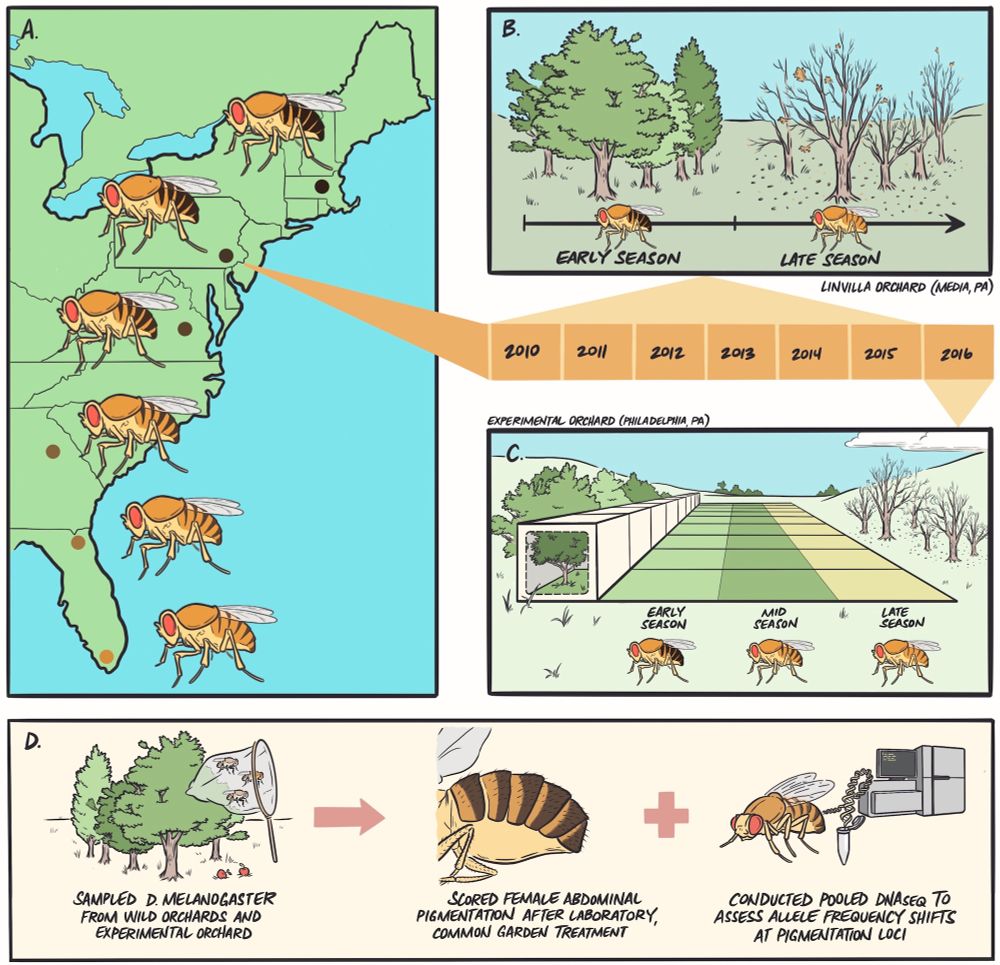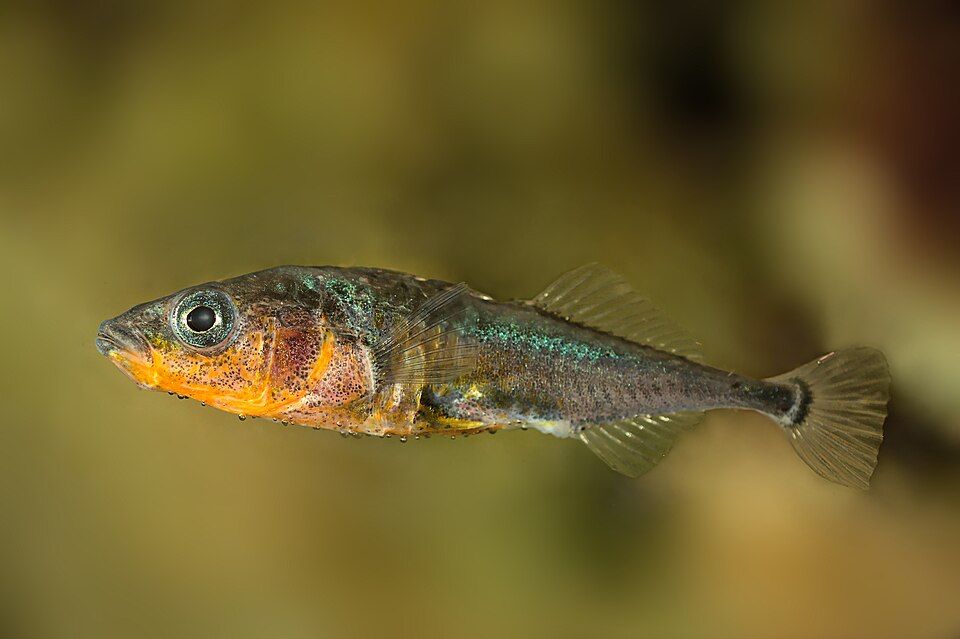Not sure our paper rocks as much as Katharina’s cover illustration, but we’re very delighted it was picked as ‘Editor’s Choice’ on @evolletters.bsky.social!
04.12.2025 17:03 — 👍 62 🔁 9 💬 2 📌 0

Check out our cover article by @timjanicke.bsky.social and colleagues about the role of sexual selection in animal speciation. academic.oup.com/evlett/artic.... The beautiful illustration is by Katharina Bóth.
04.12.2025 16:04 — 👍 266 🔁 85 💬 7 📌 13

A photo of a heard of 13 Soay sheep on Flat Holm Island, Wales. The sheep are clustered close together, and are a mixture of dark brown and light colors.
An early-life survival and reproductive trade-off shapes selection on body size
doi.org/10.1093/evle...
Now in @evolletters.bsky.social by Maria João Janeiro et al.
📷: Sam Whitfield
02.12.2025 21:15 — 👍 7 🔁 2 💬 0 📌 0

Text: Society for the Study of Evolution SSE Presidents' Award for Outstanding Dissertation Paper, Deadline January 30. Recent covers of Evolution Letters and Evolution.
Did you publish part of your PhD work in @journal-evo.bsky.social or @evolletters.bsky.social this year? Submit your paper for the SSE Presidents’ Award! Up to two recipients will each present an award talk during the virtual portion of #Evol2026 in May. Deadline: January 30. shorturl.at/CnVo6
20.11.2025 16:16 — 👍 9 🔁 7 💬 0 📌 0

Graphic from the paper showing four areas where our understanding of thermal biology can be improved by combining surface (Ts) and/or body (Tb) temperatures with other types of data, such as BMR (“basal metabolic rate”) and ambient temperatures (TA).
Infrared thermography is a useful tool in research on thermoregulation and evolution of heat tolerance
doi.org/10.1093/evle...
Now in @evolletters.bsky.social by Erik I Svensson et al.
17.11.2025 15:31 — 👍 7 🔁 1 💬 1 📌 0

Live birth in lizards: A process-based model for the roles of temperature, behavior, and life-history
To mediate trade-offs between survival and fecundity, multiple groups have independently evolved live birth (viviparity), including 70 transitions in lizar
Check our new paper in @evolletters.bsky.social "Live birth in lizards: A process-based model for the roles of temperature, behavior, and life-history"
In this study, we develop and validate a model capable of accurately predicting gestation length in lizards!
academic.oup.com/evlett/advan...
12.11.2025 18:52 — 👍 10 🔁 4 💬 1 📌 0
Validate User
🪰🧪 now out in @evolletters.bsky.social, social environmental effects on Drosophila lifespan and reproductive senescence mean females not males "live fast, die young"! Work led by Lauren Harrison and Tracey Chapman, with @alexeimaklakov.bsky.social, funded by BBSRC @ukri.org doi.org/10.1093/evle...
11.11.2025 09:49 — 👍 10 🔁 3 💬 0 📌 0

Did you publish part of your PhD work in Evolution or Evolution Letters this year? You may be eligible for this award! Papers must have been included in a 2025 issue to be eligible. Apply by January 30: shorturl.at/CnVo6
@journal-evo.bsky.social @evolletters.bsky.social
31.10.2025 12:22 — 👍 8 🔁 6 💬 0 📌 0

Sexual selection and speciation: a meta-analysis of comparative studies
Abstract. Understanding the drivers of biodiversity is a central goal in evolutionary biology. In particular, sexual selection has long been proposed as a
Does #SexualSelection fuel #Speciation?
Our new #meta-analysis of comparative studies finds support for a positive relationship, but the rather moderate global effect suggests it’s not necessarily a dominant force.
doi.org/10.1093/evle...
22.10.2025 11:24 — 👍 61 🔁 30 💬 4 📌 1

A photo of Cardamine hirsuta showing a bifurcating green shoot with elongated leaves along the ends. A cluster of white flowers is starting to bloom in the middle of the shoot.
Alignment across taxonomic levels in strategies rather than in traits along elevational gradients
doi.org/10.1093/evle...
Now in @evolletters.bsky.social by Aaditya Narasimhan & Yvonne Willi
📷: Kevin Thiele
16.10.2025 15:43 — 👍 4 🔁 1 💬 0 📌 1

A water flea of genus Daphnia in lateral view, showing an orange embryo in the brood pouch and greenish digestive tract through its transparent carapace. Credit: WikimediaCommons
Rapid temporal adaptation structures tolerance to toxic cyanobacteria in a natural population of the water flea Daphnia
doi.org/10.1093/evle...
Now in @evolletters.bsky.social by Maxime Fajgenblat et al.
📷: Janek Lass
23.09.2025 16:12 — 👍 13 🔁 4 💬 0 📌 0

A water flea of genus Daphnia in lateral view, showing an orange embryo in the brood pouch and greenish digestive tract through its transparent carapace. Credit: WikimediaCommons
Rapid temporal adaptation structures tolerance to toxic cyanobacteria in a natural population of the water flea Daphnia
doi.org/10.1093/evle...
Now in @evolletters.bsky.social by Maxime Fajgenblat et al.
📷: Janek Lass
23.09.2025 16:12 — 👍 13 🔁 4 💬 0 📌 0

Cover of the new issue of Evolution Letters @evolletters.bsky.social featuring our stickleback-tapeworm paper. academic.oup.com/evlett
What happens to immunity and infection prevalence in the 50 years after a host invades a new location
13.09.2025 16:28 — 👍 42 🔁 14 💬 1 📌 0

Figure showing the experimental overview as a graphic. Remaining alt text taken from the figure caption in the paper: (A) we sampled flies from six wild orchard populations ranging from Homestead, FL, to Lancaster, MA, and established isofemale lines in the laboratory. (B) We returned to a focal orchard in Media, PA, at early- and late-season timepoints and collected flies to capture evolutionary patterns following winter and summer conditions. (C) We then seeded outdoor mesocosms (N = 9) with an outbred population originating from early-season collections in Media, PA, and sampled flies at the end of summer (mid-season) and fall (late-season) to determine if seasonal patterns are recapitulated in experimental populations controlled for migration, drift, and cryptic population structure. (D) Across each wild or experimental context, we sampled flies, established lines in the lab, completed common garden treatment to remove environmental effects, and scored females for abdominal pigmentation. We also conducted pooled DNA sequencing on additional flies sampled from each population to map genomic patterns for candidate pigmentation SNPs.
How predictably does complex trait adaptation proceed over space and time in wild populations?
doi.org/10.1093/evle...
Now in @evolletters.bsky.social by @skylerberardi.bsky.social, @paulrschmidt.bsky.social et al.
📷: Dr. Rush Dhillon
31.07.2025 18:35 — 👍 27 🔁 12 💬 0 📌 1

A photo of a threespine stickleback (Gasterosteus aculeatus), a small, elongate fish with iridescent green color along the back and translucent fins.
Dynamics of infection and immunity over 50 years as marine stickleback adapt to freshwater
doi.org/10.1093/evle...
Now in @evolletters.bsky.social by Pranav Sriramulu et al.
📷: Gilles San Martin
07.08.2025 20:00 — 👍 21 🔁 8 💬 2 📌 0

Illustration of projected changes in leaves. Three possible scenarios are shown as green shoots of different lengths with different densities of projected leaves.
Changes to a leaf trait due to adaptive evolution and plasticity can rescue subalpine populations from the detrimental effects of climate change
doi.org/10.1093/evle...
Now in @evolletters.bsky.social by Diane R Campbell, @jellyturtle.bsky.social, and Justin Kipness
Illustration by J. Francis
11.09.2025 14:56 — 👍 16 🔁 6 💬 0 📌 1

Illustration of projected changes in leaves. Three possible scenarios are shown as green shoots of different lengths with different densities of projected leaves.
Changes to a leaf trait due to adaptive evolution and plasticity can rescue subalpine populations from the detrimental effects of climate change
doi.org/10.1093/evle...
Now in @evolletters.bsky.social by Diane R Campbell, @jellyturtle.bsky.social, and Justin Kipness
Illustration by J. Francis
11.09.2025 14:56 — 👍 16 🔁 6 💬 0 📌 1

A photo of prairie blazing star (Liatris pycnostachya), wild bergamot (Monarda fistulosa), and black-eyed Susan (Rudbeckia hirta) in bloom in the Big Stone National Wildlife Refuge in Minnesota.
Genetic divergence in population mean fitness is weakly associated with environmental and geographic distance in four prairie perennial forbs
doi.org/10.1093/evle...
Now in @evolletters.bsky.social by Anna R Peschel et al.
📷: Mike Budd/USFWS
03.09.2025 18:16 — 👍 10 🔁 4 💬 0 📌 0

A photo of prairie blazing star (Liatris pycnostachya), wild bergamot (Monarda fistulosa), and black-eyed Susan (Rudbeckia hirta) in bloom in the Big Stone National Wildlife Refuge in Minnesota.
Genetic divergence in population mean fitness is weakly associated with environmental and geographic distance in four prairie perennial forbs
doi.org/10.1093/evle...
Now in @evolletters.bsky.social by Anna R Peschel et al.
📷: Mike Budd/USFWS
03.09.2025 18:16 — 👍 10 🔁 4 💬 0 📌 0

Rostral (C) and caudal (D) view of volumetric reconstructions of the brains of wild male H. e. venus (left half) and H. chestertonii (right half)
Repeated evolution of reduced visual investment at the onset of ecological speciation in high-altitude Heliconius butterflies
doi.org/10.1093/evle...
Now in @evolletters.bsky.social by David F Rivas-Sánchez et al.
25.08.2025 20:37 — 👍 10 🔁 1 💬 0 📌 0

Rostral (C) and caudal (D) view of volumetric reconstructions of the brains of wild male H. e. venus (left half) and H. chestertonii (right half)
Repeated evolution of reduced visual investment at the onset of ecological speciation in high-altitude Heliconius butterflies
doi.org/10.1093/evle...
Now in @evolletters.bsky.social by David F Rivas-Sánchez et al.
25.08.2025 20:37 — 👍 10 🔁 1 💬 0 📌 0

Editorial: Accountability, voice, and trust - responsible use of GenAI in scientific publishing
Over the last few years, the development and rapid advancement of Generative Artificial Intelligence (GenAI) and Large Language Models (LLMs) such as ChatG
Many of us are using LLMs in coding and scientific writing. They are very helpful tools, but we need to be thoughtful as we integrate them into our work flows to preserve accountability, voice and trust. academic.oup.com/evlett/advan.... An editorial at @evolletters.bsky.social for discussion:
22.08.2025 12:52 — 👍 71 🔁 33 💬 2 📌 3

A photo of Drosophila melanogaster on a leaf.
Continent-wide differentiation of fitness traits and patterns of climate adaptation among European populations of Drosophila melanogaster
doi.org/10.1093/evle...
Now in @evolletters.bsky.social by Esra Durmaz Mitchell et al.
Drosophila melanogaster
11.08.2025 16:59 — 👍 23 🔁 7 💬 0 📌 0
#WomeninSTEM working @mecadev.bsky.social @mnhn.fr, exploring functional #morphology and #biomechanics of birds🐥🦖
Interested in #locomotion 🐧🦅🐤 #birdsong 🎶🐦, #feeding 🦆
Curator of the MNHN digital collection, in charge of @e-colplus.bsky.social
She/Her
Evolutionary geneticist with a particular interest in sexual dimorphism and sex chromosome evolution. Senior Lecturer at University of Sheffield www.alisonewright.co.uk
I chase lizards around professionally. PhD. Candidate, University of Nevada, Reno (he/him): https://sites.google.com/view/ggcostoya
Professor of Behavioural Ecology, University of Leeds, UK. The biology of sex and social environments, and Thermal Fertility Limits, mainly of fruit flies.
Evolution, development and developmental evolution. Neural crest cells, color patterns and the evolution of phenotypic syndromes. Postdoc at Max Plank Institute for Evolutionary Biology.
Evolutionary biology | Behavioural ecology | Sexual selection
@CNRS, CEFE, Montpellier
🏔️ 🌱 Postdoc @Uni Lausanne
Interested in limits to evolution, developmental constraints, evolutionary quant gen and pop gen | PhD@UniversitätBasel
Sniffing out floral scent evolution across Hawai'i and the Rockies. Environmental education is good for everyone. Find me looking for rain beetles and other critters.
Professor of ecology and evolution @ UConn. Studies adaptation, evolutionary immunology, speciation, genomics, foraging, parasite ecology and more.
Hikes, rock climbs, tango, history buff, photographer & parent
Postdoctoral Researcher
Kim Lab @ Princeton EEB
Associate professor in Biology @stfxuniversity
evolutionary biologist. behavioural entomologist 🇨🇦🇬🇧🇨🇦
Senior Lecturer (Associate Prof) & Fellowship Lead
Dept of Ecology Evolution & Behaviour, Uni of Liverpool
Evolution / Life-history / Sexual selection / Ageing / Nutrition / Thermal Fertility / Drosophila
http://wigbylab.weebly.com
Sex, conflict, sociality, evolution. Associate Professor UNIVET Budapest (he/him)
Evolutionary biologist @ UBC.
sci art knitting baking biking fish
jacelyndesigns.com
Virus evolution, ecology and host shifts. Fly zookeeper. Insect rhabdovirus geek. Tea Junkie. Like music, food, bikes. Lab website: www.benlongdon.com
Evolutionary biologist with a focus on genomics and developmental processes. Currently an NSF postdoctoral fellow in the Clark Lab at the University of Pittsburgh. Proud to be Asian American and a woman in STEM! she/her
Associate Professor of Biological Sciences at University of Pittsburgh.
Adaptive and Convergent Evolution in response to extreme environments. Phylogenetics. Diving mammals. Subterranean life. Visual adaptations.
http://nclarklab.org
Post-doc at UNIL | Inbreeding depression and quant gen in wild populations 🦉🦌 .. occasionally dabbling in popgen | Happiest when gallivanting outside 🏃♀️🏊♀️🚴♀️🏔 | She / her





















